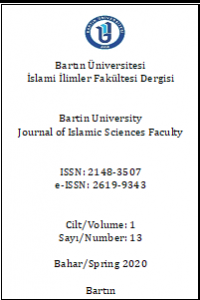Abstract
Mübhem kelimesi anlaşılması zor olan, kendisinden ne kastedildiği belli olmayan şey anlamına gelmektedir. Kur’ân ilimleri tedvin edilme açısından değerlendirildiğinde, Mübhemâtu’l-Kur’an ilminin son sıralarda yer aldığı söylenebilir. Bu bağlamda Mübhemâtu’l-Kur’an ilmi Kur’an’da geçen belirsizlikleri incelemeyi konu edinmekte ve bu belirsizliklerin giderilmesini amaçlamaktadır. Kur’an’ın üslup özelliklerinden olan mübhemâtın tespitinde kişisel görüşün değil, naklin (rivayet/haber) esas alınması ve bu konuda Hz. Peygambere (s.a.v.), Ashaba ve Tabiîne başvurulması gerektiği savunulmaktadır. Kur’an’da zikredilen dağlar, vadiler, yerleşim yerleri ve mescitler mekânla ilgili mübhemleri oluşturmaktadır. Bu çalışmada Ebu’l-Kâsım Mahmûd ibn Ömer ez-Zemahşerî’nin dilbilimsel (filolojik) bir tefsir olarak bilinen “el-Keşşâf an Hakâiki’t-Tenzil ve Uyûni’l-Akâvîl fî Vucûhi’t-Te’vîl” adlı eserinde mekânla ilgili mübhemlere ne ölçüde yer verdiğini ve bunları açıklarken nasıl bir yöntem izlediğini ortaya koymak hedeflenmiştir. Zemahşerî mübhem tabirini mecazen iş ve söz için kullanmaktadır. Onun el-Keşşâf’ında yer verdiği mekânla ilgili mübhemler; dağlar, vadiler, yer isimleri ve mescitler olmak üzere dört grupta ele alınmıştır.
Keywords
References
- Albayrak, Halis. “Mübhematu’l-Kur’an İlmi ve Kur’an Tefsirindeki Yeri”. Ankara Üniversitesi İlahiyat Fakültesi Dergisi 32 (1992), 155-182.
- Albayrak, Halis. Tefsir Usulü. İstanbul: Şûle Yayınları, 1998.
- Birışık, Abdülhamit- Hüseyin, Abdülhâdî, Muhammed. “Mübhemâtü’l-Kur’an”. Türkiye Diyanet Vakfı İslam Ansiklopedisi. 31/437-439. İstanbul: TDV Yayınları, 2006.
- Brockelmann, Carl. Geschichte der Arabischen Litteratur. Supplmmentband, Leiden: Brill, 1938.
- Cerrahoğlu, İsmail. Tefsir Usulü. Ankara: Türkiye Diyanet Vakfı Yayınları, 23. Basım, 2012.
- Demirci, Muhsin. Tefsir Usûlü. İstanbul: Marmara Üniversitesi İlahiyat Fakültesi Vakfı Yayınları, 2013.
- İbn Manzur. Lisanül Arab. thk. Ali Şîrî. 1-18 Cilt. Beyrut: Daru’l-Hayai Turâsi’l-Arabî, 1988.
- İsfahanî, Rağıb. Müfredât Kur’ân Kavramları Sözlüğü. çev. Abdulbaki Güneş- Mehmet Yolcu. İstanbul: Çıra Yayınları, 3. Basım, 2012.
- Mâtürîdî, Ebu Mansur Muhammed b. Muhammed es-Semerkandî. Te’vîlâtü’l Kur’an. thk. Muhammed Böynukalın. 18 Cilt. İstanbul: Dâru’l-Mîzân, 2005-2011.
- Suyutî, Celaleddin. Mufhemâtu’l-Ekrân fî Mubhemâti’l-Kur’ân. thk. Mustafa Dîb el-Bağâ. Dımaşk: Müesesetü Ulûmi’l-Kur’ân, 1982.
- Suyutî, Celaleddin. el-İtkan fî Ulumi’l-Kur’an. 2 Cilt. thk. Mustafa Şeyh Mustafa. Dımaşk: er-Rissale, 2013.
- Yüksel, Muhammed Bahaeddin. “Mahiyet ve Muhatap Açısından Mübhemâtu’l-Kur’an”. Dini Araştırmalar 21/53 (2018), 55-77.
- Zemahşerî, Ebu’l-Kâsım Mahmûd İbn Ömer. el-Keşşâf an Hakâiki’t-Tenzil ve Uyûni’l-Akâvîl fî Vucûhi’t-Te’vîl. 4 Cilt. thk. Mustafa Hüseyin Ahmed. Kahire: Daru’r-Reyyân li’t-Turâs, 1987.
- Zemahşerî, Ebu’l-Kâsım Mahmûd İbn Ömer. Esasu’l-Belağa. 2 Cilt. thk. Muhammed Bâsil U’yûn es-Sûd. Lübnan: Dâru’l-Kutubi’l- İlmiyye, 1998.
- Zerkeşî, Bedruddîn Muhammed b. Abdullah. el-Burhân fî Ulumi’l-Kur’an. thk. Ebi’l-Fadl ed-Dimyâti. Kâhire: Dâru’l-Hadis, 2006.
Abstract
The word “Mubham” means hard to understand, and it’s not clear what is meant by it. When the Quranic sciences are evaluated in terms of the treatment, it can be said that the science of Mübhemâtu'l-Kur'an is in the last ranks. In this context, the science of Mubhamat al- Quran also aims to examine the uncertainties in the Quran and aims to eliminate these uncertainties. The determination of the good news, which is one of the stylistic features of the Quran, is not based on personal opinion, but on the transfer (narration / news) and it is claimed that the Holy Prophet of Islam, Ashaba and Tabiîn should be applied. The mountains, valleys, settlements and masjids in the Quran make up the “mubhams” of the place. In Abu’l-Qasim Mahmud ibn Umar al-Zamakhshari's “Al-Kashshaf `an Haqa’iq al-tan’zil va Uyun al-Aqavil fi Vucuh at-Ta'vil” known as a linguistic (philological) commentary, he explains how much he used mubhams concerning the place and the methods he employed in explaining them. This research is important in terms of revealing the “mubhams” Zamakhshari mentioned and methods he followed in his work. Zamakhshari uses the phrases “Mubham” metaphorically for work and word. The mubhams regarding the places mentioned in his work al-Kashshaf will be discussed in four groups: valleys, place names, masjids and mountains.
Keywords
References
- Albayrak, Halis. “Mübhematu’l-Kur’an İlmi ve Kur’an Tefsirindeki Yeri”. Ankara Üniversitesi İlahiyat Fakültesi Dergisi 32 (1992), 155-182.
- Albayrak, Halis. Tefsir Usulü. İstanbul: Şûle Yayınları, 1998.
- Birışık, Abdülhamit- Hüseyin, Abdülhâdî, Muhammed. “Mübhemâtü’l-Kur’an”. Türkiye Diyanet Vakfı İslam Ansiklopedisi. 31/437-439. İstanbul: TDV Yayınları, 2006.
- Brockelmann, Carl. Geschichte der Arabischen Litteratur. Supplmmentband, Leiden: Brill, 1938.
- Cerrahoğlu, İsmail. Tefsir Usulü. Ankara: Türkiye Diyanet Vakfı Yayınları, 23. Basım, 2012.
- Demirci, Muhsin. Tefsir Usûlü. İstanbul: Marmara Üniversitesi İlahiyat Fakültesi Vakfı Yayınları, 2013.
- İbn Manzur. Lisanül Arab. thk. Ali Şîrî. 1-18 Cilt. Beyrut: Daru’l-Hayai Turâsi’l-Arabî, 1988.
- İsfahanî, Rağıb. Müfredât Kur’ân Kavramları Sözlüğü. çev. Abdulbaki Güneş- Mehmet Yolcu. İstanbul: Çıra Yayınları, 3. Basım, 2012.
- Mâtürîdî, Ebu Mansur Muhammed b. Muhammed es-Semerkandî. Te’vîlâtü’l Kur’an. thk. Muhammed Böynukalın. 18 Cilt. İstanbul: Dâru’l-Mîzân, 2005-2011.
- Suyutî, Celaleddin. Mufhemâtu’l-Ekrân fî Mubhemâti’l-Kur’ân. thk. Mustafa Dîb el-Bağâ. Dımaşk: Müesesetü Ulûmi’l-Kur’ân, 1982.
- Suyutî, Celaleddin. el-İtkan fî Ulumi’l-Kur’an. 2 Cilt. thk. Mustafa Şeyh Mustafa. Dımaşk: er-Rissale, 2013.
- Yüksel, Muhammed Bahaeddin. “Mahiyet ve Muhatap Açısından Mübhemâtu’l-Kur’an”. Dini Araştırmalar 21/53 (2018), 55-77.
- Zemahşerî, Ebu’l-Kâsım Mahmûd İbn Ömer. el-Keşşâf an Hakâiki’t-Tenzil ve Uyûni’l-Akâvîl fî Vucûhi’t-Te’vîl. 4 Cilt. thk. Mustafa Hüseyin Ahmed. Kahire: Daru’r-Reyyân li’t-Turâs, 1987.
- Zemahşerî, Ebu’l-Kâsım Mahmûd İbn Ömer. Esasu’l-Belağa. 2 Cilt. thk. Muhammed Bâsil U’yûn es-Sûd. Lübnan: Dâru’l-Kutubi’l- İlmiyye, 1998.
- Zerkeşî, Bedruddîn Muhammed b. Abdullah. el-Burhân fî Ulumi’l-Kur’an. thk. Ebi’l-Fadl ed-Dimyâti. Kâhire: Dâru’l-Hadis, 2006.
Details
| Primary Language | Turkish |
|---|---|
| Subjects | Religious Studies |
| Journal Section | Article |
| Authors | |
| Publication Date | June 30, 2020 |
| Submission Date | June 14, 2019 |
| Published in Issue | Year 2020 Volume: 1 Issue: 13 |

